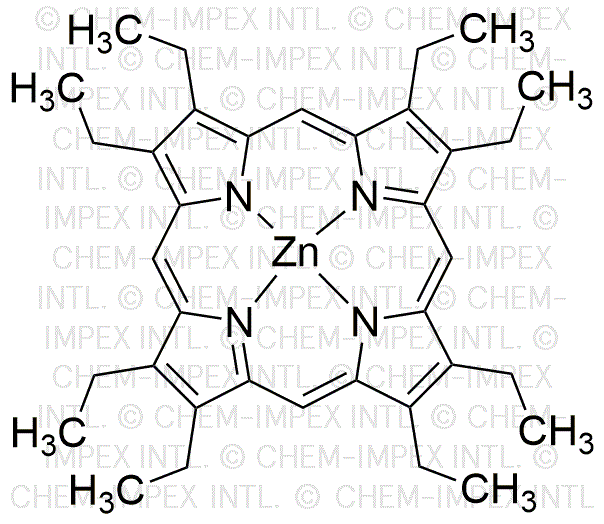Zinc(II) 2,3,7,8,12,13,17,18-(octaethyl)porphyrin is widely utilized in research focused on:
- Photodynamic Therapy: This compound is used in medical applications for targeted cancer treatment. Its ability to produce reactive oxygen species upon light activation makes it effective in destroying cancer cells while minimizing damage to surrounding healthy tissue.
- Solar Energy Conversion: In the field of renewable energy, it serves as a key component in dye-sensitized solar cells, enhancing their efficiency by improving light absorption and energy conversion rates.
- Biochemical Sensors: The compound is employed in the development of sensors for detecting various biomolecules. Its unique properties allow for sensitive and selective detection, which is crucial in medical diagnostics and environmental monitoring.
- Catalysis: It acts as a catalyst in various chemical reactions, particularly in organic synthesis. Its efficiency in facilitating reactions can lead to reduced reaction times and improved yields compared to traditional catalysts.
- Material Science: This chemical is used in creating advanced materials, such as conductive polymers and nanomaterials, which have applications in electronics and nanotechnology, offering enhanced performance and functionality.
General Information
Properties
Safety and Regulations
Applications
Zinc(II) 2,3,7,8,12,13,17,18-(octaethyl)porphyrin is widely utilized in research focused on:
- Photodynamic Therapy: This compound is used in medical applications for targeted cancer treatment. Its ability to produce reactive oxygen species upon light activation makes it effective in destroying cancer cells while minimizing damage to surrounding healthy tissue.
- Solar Energy Conversion: In the field of renewable energy, it serves as a key component in dye-sensitized solar cells, enhancing their efficiency by improving light absorption and energy conversion rates.
- Biochemical Sensors: The compound is employed in the development of sensors for detecting various biomolecules. Its unique properties allow for sensitive and selective detection, which is crucial in medical diagnostics and environmental monitoring.
- Catalysis: It acts as a catalyst in various chemical reactions, particularly in organic synthesis. Its efficiency in facilitating reactions can lead to reduced reaction times and improved yields compared to traditional catalysts.
- Material Science: This chemical is used in creating advanced materials, such as conductive polymers and nanomaterials, which have applications in electronics and nanotechnology, offering enhanced performance and functionality.
Documents
Safety Data Sheets (SDS)
The SDS provides comprehensive safety information on handling, storage, and disposal of the product.
Product Specification (PS)
The PS provides a comprehensive breakdown of the product’s properties, including chemical composition, physical state, purity, and storage requirements. It also details acceptable quality ranges and the product's intended applications.
Certificates of Analysis (COA)
Search for Certificates of Analysis (COA) by entering the products Lot Number. Lot and Batch Numbers can be found on a product’s label following the words ‘Lot’ or ‘Batch’.
*Catalog Number
*Lot Number
Certificates Of Origin (COO)
This COO confirms the country where the product was manufactured, and also details the materials and components used in it and whether it is derived from natural, synthetic, or other specific sources. This certificate may be required for customs, trade, and regulatory compliance.
*Catalog Number
*Lot Number
Safety Data Sheets (SDS)
The SDS provides comprehensive safety information on handling, storage, and disposal of the product.
DownloadProduct Specification (PS)
The PS provides a comprehensive breakdown of the product’s properties, including chemical composition, physical state, purity, and storage requirements. It also details acceptable quality ranges and the product's intended applications.
DownloadCertificates of Analysis (COA)
Search for Certificates of Analysis (COA) by entering the products Lot Number. Lot and Batch Numbers can be found on a product’s label following the words ‘Lot’ or ‘Batch’.
*Catalog Number
*Lot Number
Certificates Of Origin (COO)
This COO confirms the country where the product was manufactured, and also details the materials and components used in it and whether it is derived from natural, synthetic, or other specific sources. This certificate may be required for customs, trade, and regulatory compliance.


